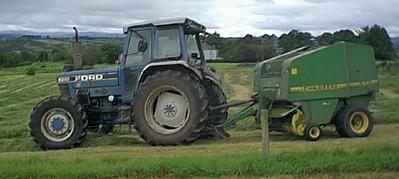Environment
Farming
Farming is a big industry in our parish. Some people are suckler farmers and some people are dairy farmers and some are tillage and some have pigs. Our farm is a mixed farm. We have bullocks such as Fresians, White Heads, and Angus. We have Milking Cows and we milk them every morning and evening. A man comes to our farm and takes away the milk to Dairygold and makes it into butter or cheese. We have pigs as well and we feed them ration everyday. When the piglets are big enough we sell them to the butcher to be killed. We use Machinery for tillage such as balers, combine, harvesters and we grow crops such as barley and wheat.



Cutting Silage.jpg
Cutting silage is one of the most important jobs on the farm. There are two ways of saving silage.You can round bale it and you can also mow down the silage and pick it up with a silage harvester or a combine harvester. It is a long process because you have to mow it down and pick it up which all takes from two to three days. After you are finished all that you have to cover the silage pit which would all take another two days. There are many types of round balers such as Wlger, Class, Krone, McHale and John Deer. Round bales are very costly to have made. Some bales could be as dear as £20 each. You usually get about 13to15 bales to the acre. Last year we had 119 round bales of silage. For pit silage we have about 40 acres. For mowing down the silage they use a 12ft mower which cost about 40,000 pounds each. The contractors back up the silage with a JCB. I love cutting silage.
These are pictures of a Ford 8210 and a John Deere round bailer.


 Explore Cusheen Wood
Explore Cusheen Wood
Cusheen Wood
Flora and Fauna
There are lots of habitats around our area. Some of them are: grasslands, woods, hedges, streams, rivers and boglands. The most significant habitat local to us is Cusheen wood. Lots of animals live in Cusheen wood. The wood gives them shelter and protection. Most of them come out at night. Some of the animals that live in the wood are Badgers, Foxes, Rabbits, Stoats, Mice, red squirrels and Rats. Foxes are small members of the dog family. They like to live alone. The red fox is found over more of the world than any other carnivore (flesh eater). It survives in almost any country. Foxes have very good sight, hearing and sense of smell. It can run fast (up to 48 km/h) over long distances, jumping or climbing over obstacles and swimming as well if need be.
 Trees
Trees
There are lots of beautiful trees in the wood. There are Oak, Ash, Horse chestnut and Beech. There are a lot of Ash trees .The Irish for Ash is fuinseog. The ash is one of the most graceful of trees, growing to a height of 50 to 80 feet with span of some 200 years. The Ash flowers in April or may though the flowers are not very attractive and are follwed by bunches of "keys" which contain the seed and are carried away by the wind when ripe. It takes 20,000Ash trees a year to keep up with the demand for hurleys. The hurley is made from the butt of the trees.
Explore River Lee
River Lee
Fish Hatchery at Carrigadrohid
Four miles east of Macroom there is a village called Carrigadrohid. This is the most southerly village in our parish.. In 1958 one year after the Lee Hydro electric scheme went into operation the E.S.B began a large scale fisheries development programme on the river. This work began with the hatching out of young salmon in the Lee. The young salmon were planted in the river a few weeks after they were hatched. An important phase in the fisheries took place in 1971 when a major new salmon rearing station was opened by the E.S.B at Carrigadrohid. The rearing station gives an added advantage of bringing the fry to the stage when they are ready to go to the sea, and avoiding all hazards they would encounter if they were released as fry into the river. The capacity of the rearing station when it was opened was 170,000 salmon smolts, plus 700,000 ova or eggs . Since it was opened,1.5 million smolts have been placed in the Lee hatchment area.The rearing station has been extended and the capacity of the station now is 320,000 salmon smolts per year and 1.2 million ova or eggs.
Back to Homepage
Top






